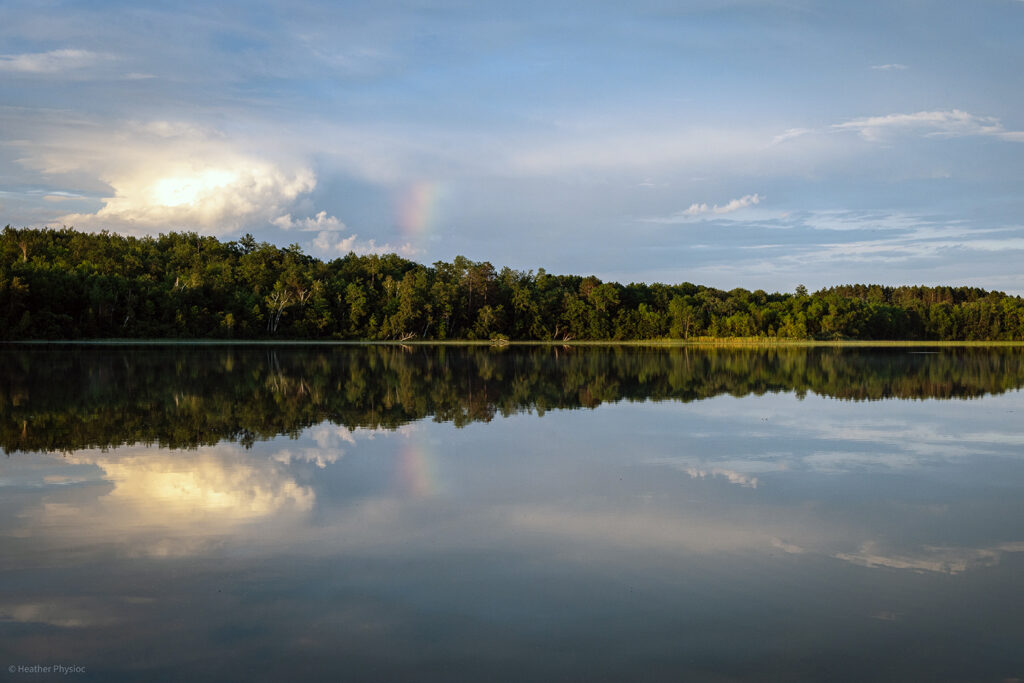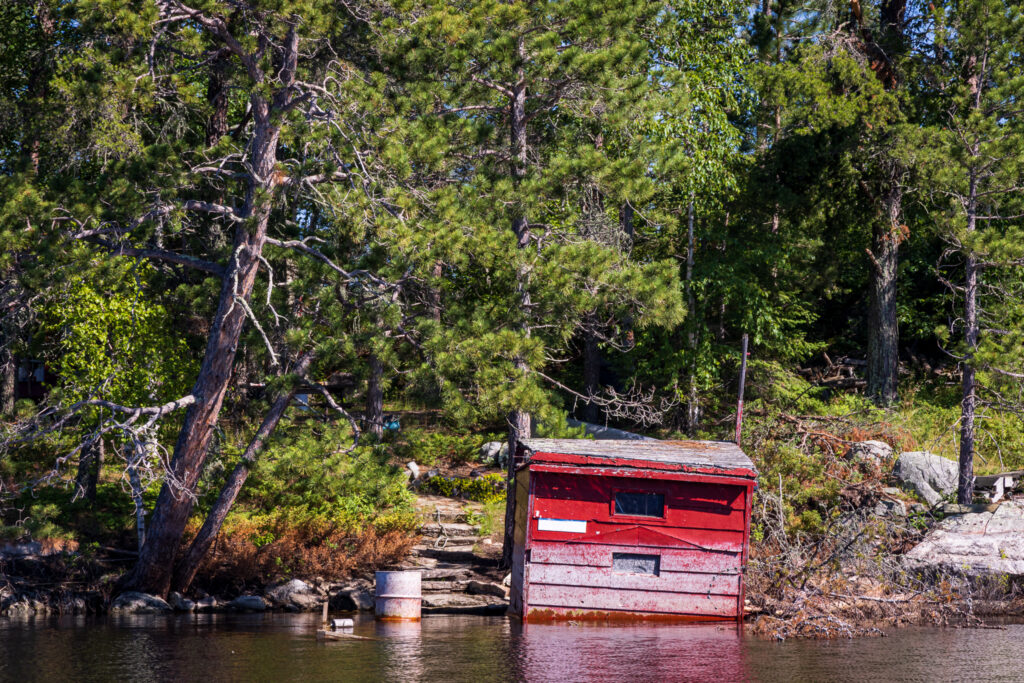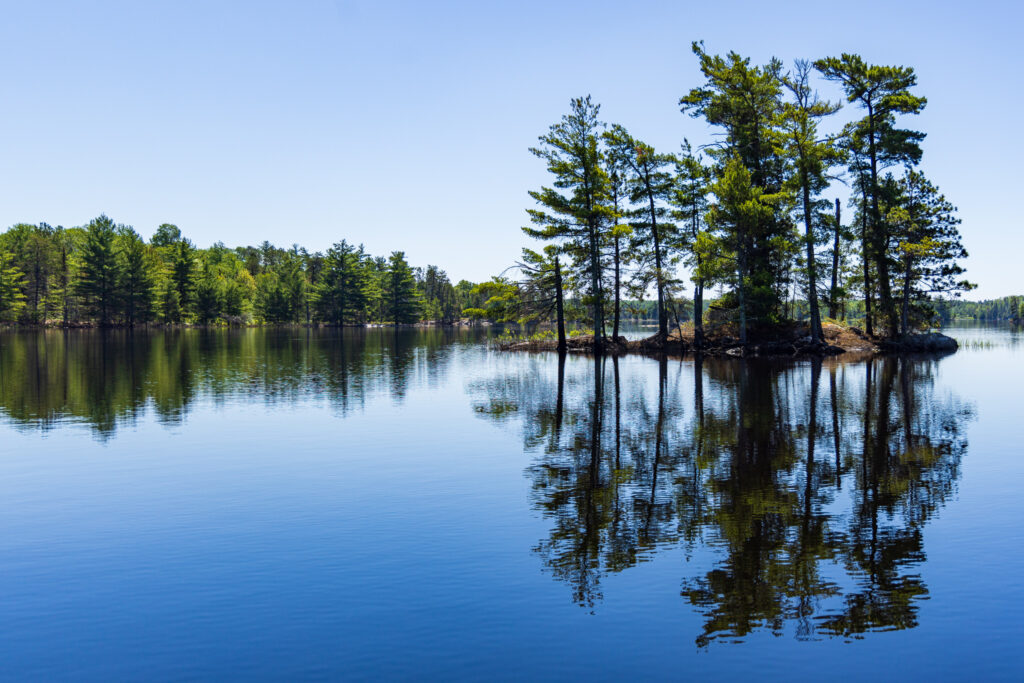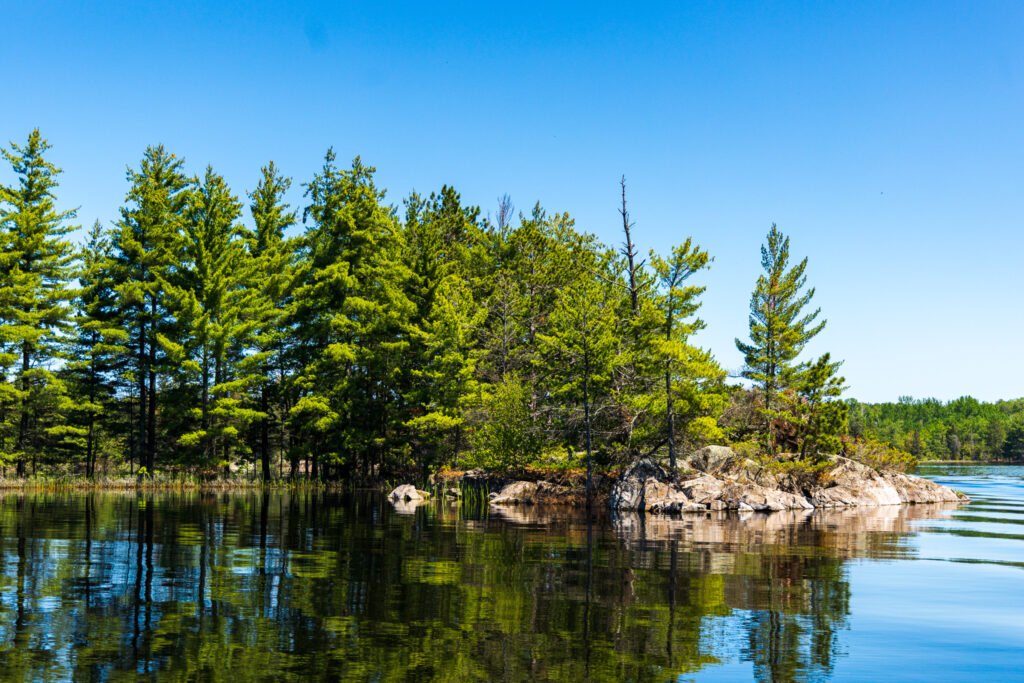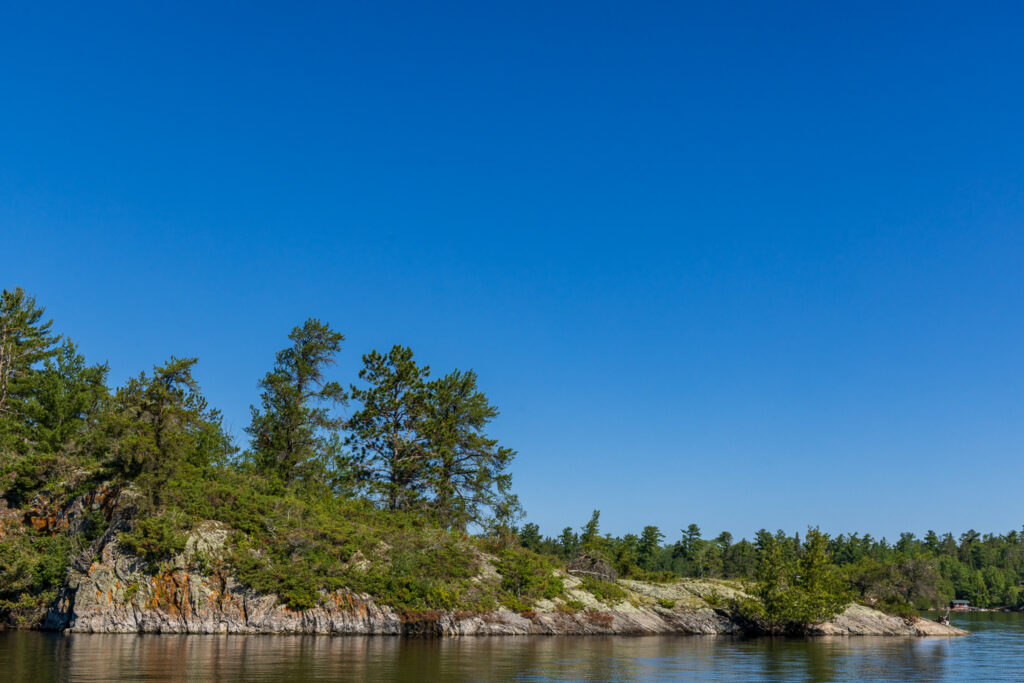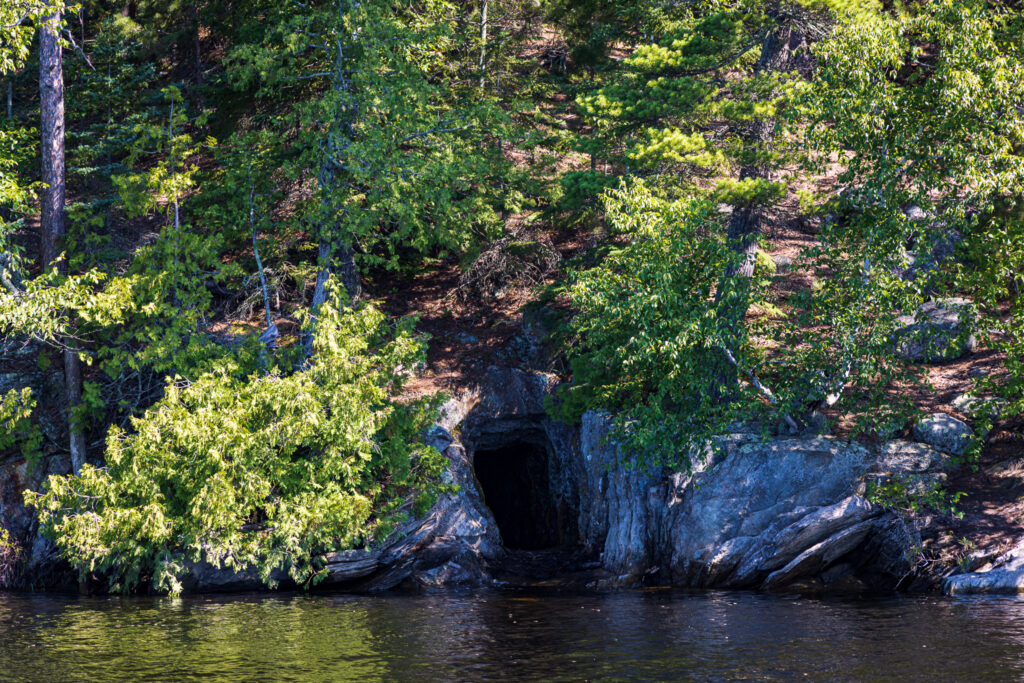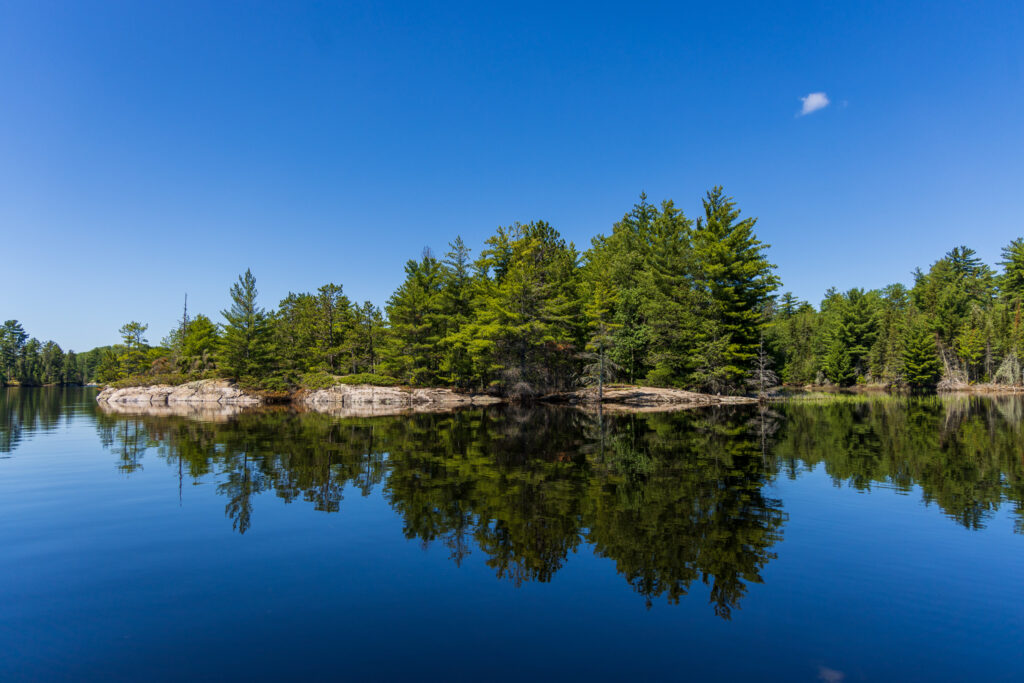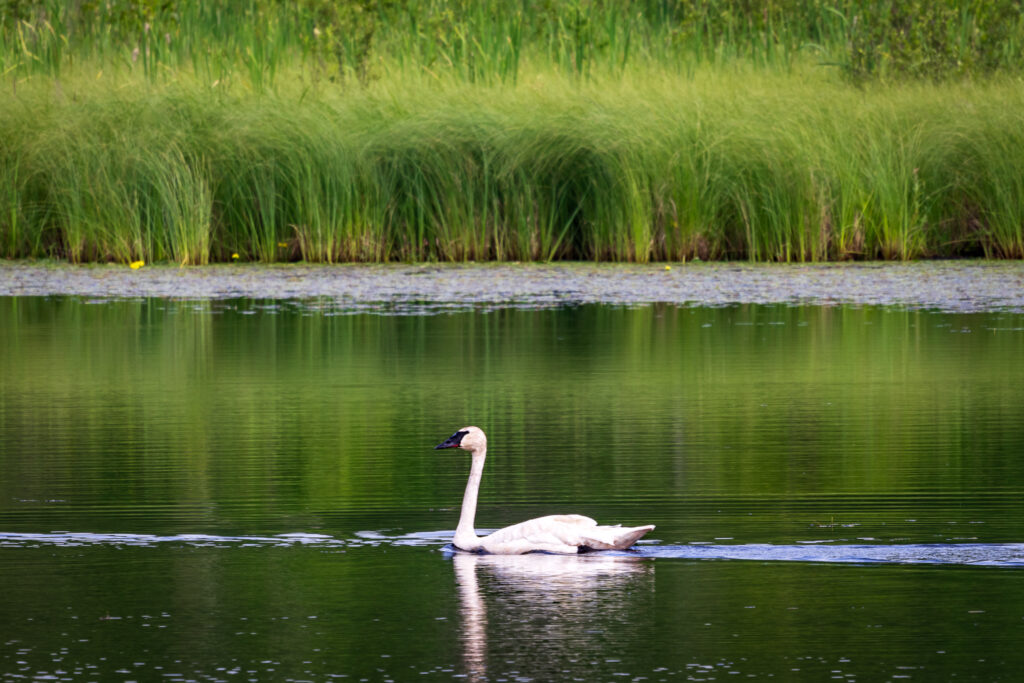It appears that 2022 is the year I visit national parks experiencing extraordinary flooding events. In the spring, massive flooding washed out vast parts of Yellowstone National Park just after I visited during record snow. And recently, I visited Voyageurs National Park in Minnesota just after historic flooding caused by heavy rains and snowmelt in the late spring. The flooding has eroded shoreline, caused damage to structures, closed campsites, canceled tours, and submerged docks or sent them floating away if sandbags didn’t hold them.
Still, Voyageurs National Park is a beauty. While it has 100 miles of boreal forest trail available to hike, unlike the typical U.S. national park, this one is best experienced on the water. It features four major lakes – Rainy, Kabetogama, Namakan and Sand Point – and about two dozen smaller lakes. The park has an estimated 500 islands in the lakes, though I have to imagine this count varies depending on the water level.
The Canadian border bisects Rainy Lake on the north side of the 218,000-acre park, on the outer edges of the Canadian Shield. The Northern Lights (a bucket list item for me) can be seen from north-facing clearings in the park up to 200 times per year.
Boundary Waters Beauty
Voyageurs National Park is an amphibious place. Land meets water. Wild meets developed. It is home to numerous lakes, rivers, streams, and inlets. The southern boreal forest of spruce, aspen, fir and paper birch meets the northern hardwood forest of pine, oak and maple. In the summer, wildflowers and berries are plentiful. Together these landscapes form a unique north midwestern brand of wetland ecosystem shared by people and wildlife.
Cliffs and exposed rock ledges form the outer edges of the hundreds of islands dispersed through the water. The exposed rock was born of volcanic bedrock from massive eruptions that deposited ash and lava. Extremely high temperatures and pressure formed igneous and metamorphic rock half the age of the earth itself. This rock once held gold in quartz veins and initiated a brief 19th-century gold rush. That same rock has been shaped and eroded over eons by glacial waters to create the lake landscape.
Voyageurs receives about 230,000 visitors annually. People travel to Voyageurs to enjoy the beauty of its natural surroundings and intrigue of its native wildlife, but also to take the to the water by boat, kayak or canoe for fishing and watersports.
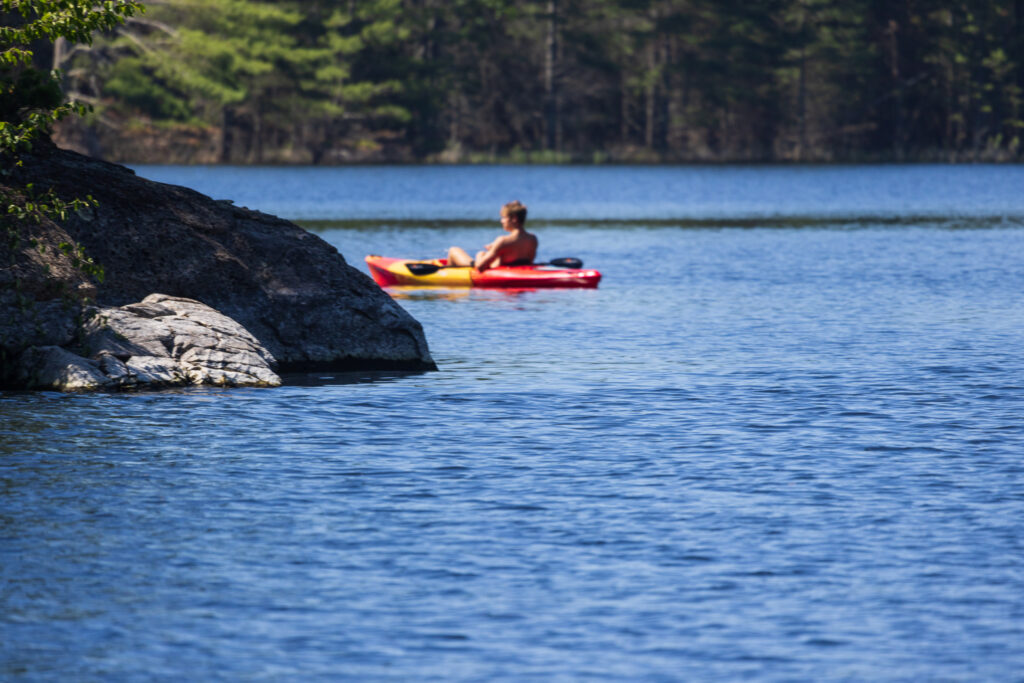
Voyageurs By Land
I spent my first day in the park on the land. I stopped by the three visitor centers to view exhibits and chat with rangers and then attempted to explore available trails on the southern part of the park on foot. First, I coasted on the comfortable Rainy Lake Recreation Trail, then went “off-road” to the Bay Ash Trail and Echo Bay Trails.
A male ruffled on the Echo Bay Trail did a showy dance on the forest floor. The North Woods is home to various animals, like moose, gray wolves, black bears, owls, and others. But other than that grouse, the only wildlife I witnessed was swarms of mosquitoes thriving in the muggy, sloppy mess. Floodwaters were still receding, and the mud wasn’t traversable in many places, so these hikes were short-lived.
I threw in the towel on hiking.
Before exiting the trail, hikers use the provided boot brushes to clean their shoes, one of several measures the National Parks Service takes to prevent the transport of exotic species between the boggy trails and lakes. Boats also undergo special cleaning processes to avoid the spread. Invasive species like wild parsnip, Canada thistle, and reed canary grass explode on land, while spiny water fleas, rusty crayfish, and zebra mussel threaten the water.
New strategy: visit the remaining Visitors Centers, popping into sites like Beaver Pond Overlook (no longer home to beavers but still houses a large dam) on the way, and walk short, accessible trails in my sandals.
Tiny Travel Tip: Pack a second pair of socks and sneakers, or a pair of sandals, as a backup for your first pair on national park visits. You may not always need them, but you’ll never regret having them when you do.
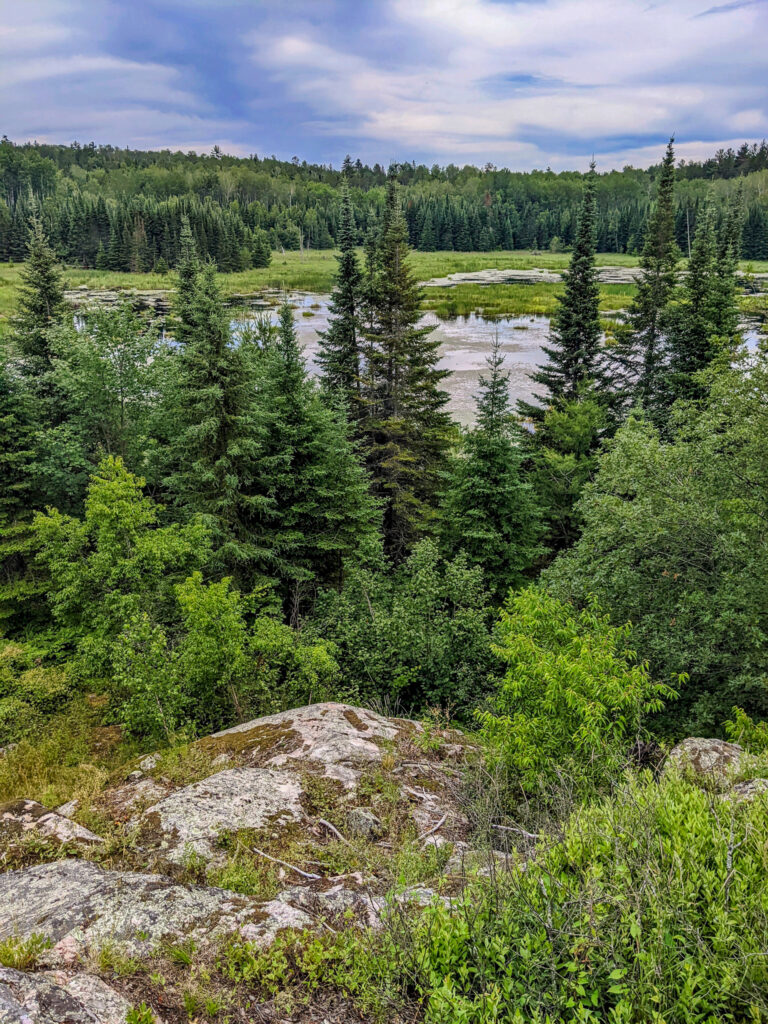
After a full – and filthy – day at Voyageurs, I had my bearings. I was looking forward to being on the water all the next day, as it’s the most important way to experience the park. A scheduling change got me an upgrade to the full-day Kettledam tour from Voyageurs Outfitters the following morning. It launched from Thunderbird Lodge, which shares the docks with giant houseboats and other watercraft for rent in the park, and ended at Kettle Falls.
Voyageurs By Water
The weather was perfectly balmy, and the water unusually still. Captain Tim steered the pontoon with me and one well-traveled retired couple from St. Louis, pointing out the sights on Rainy Lake. He told the history of Little American Island and the whimsically named Bushy Head Island, the sites of abandoned mines from the gold rush in the late 19th century.
Tim recounted stories from his childhood living in the islands and channels of the boundary waters between our two countries. He recalled old commercial fishing camps, shared tidbits about long-deceased land owners in the region, and reminisced about jumping from the bluffs into the lake as a boy.
The lakes of Voyageurs National Park are home to wildlife like deer, bears, beavers, ducks and others. Boaters occasionally see bears swimming between the islands. I scoured the shorelines to spot blackberry-loving bears stuffing themselves on the fruit or sliding into the water with no luck.
Bald eagles stood out against the blue sky with their bright white heads. There was also a bald eagle about five to six months old patiently awaiting its parents’ return in their giant aerie in the treetops.
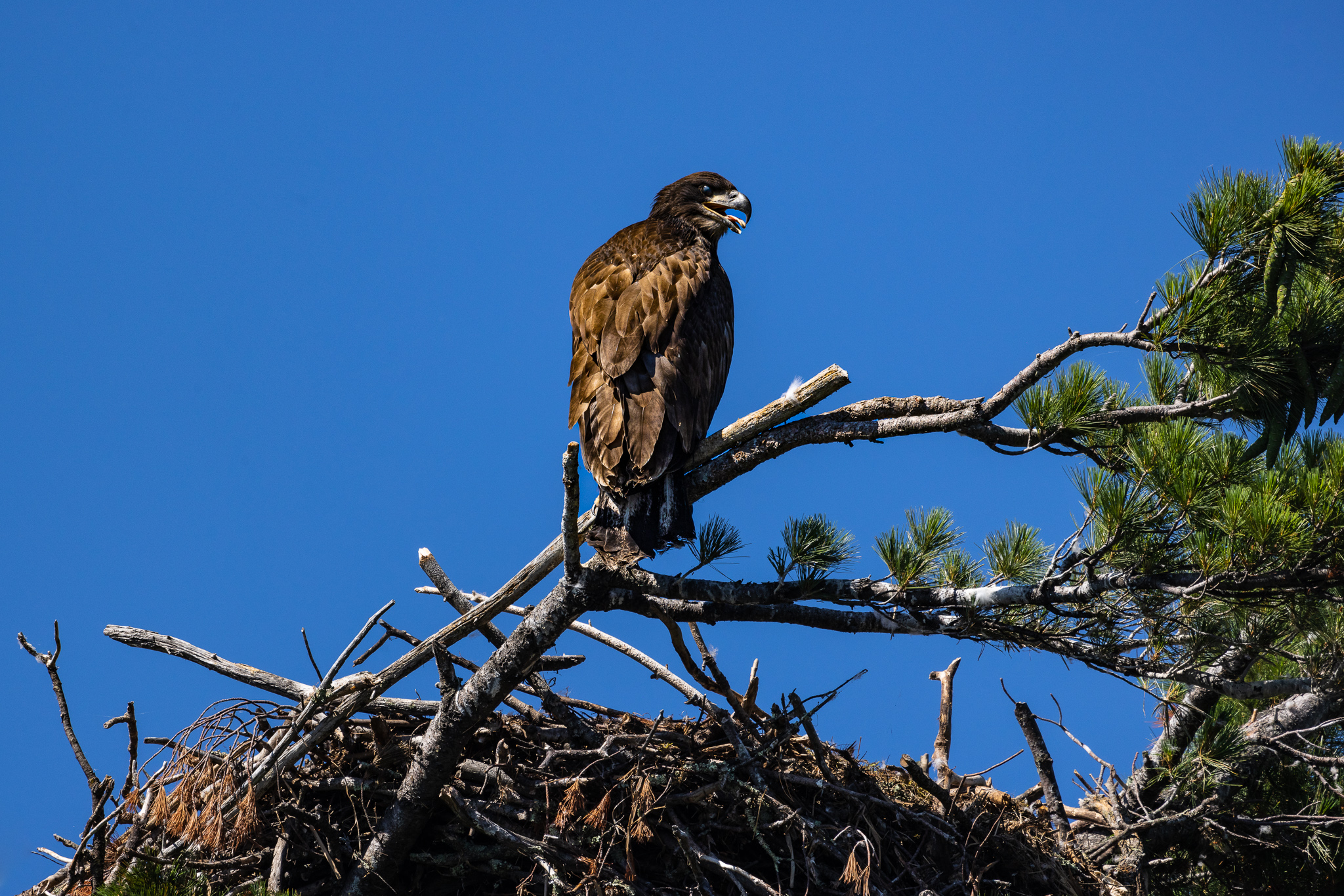
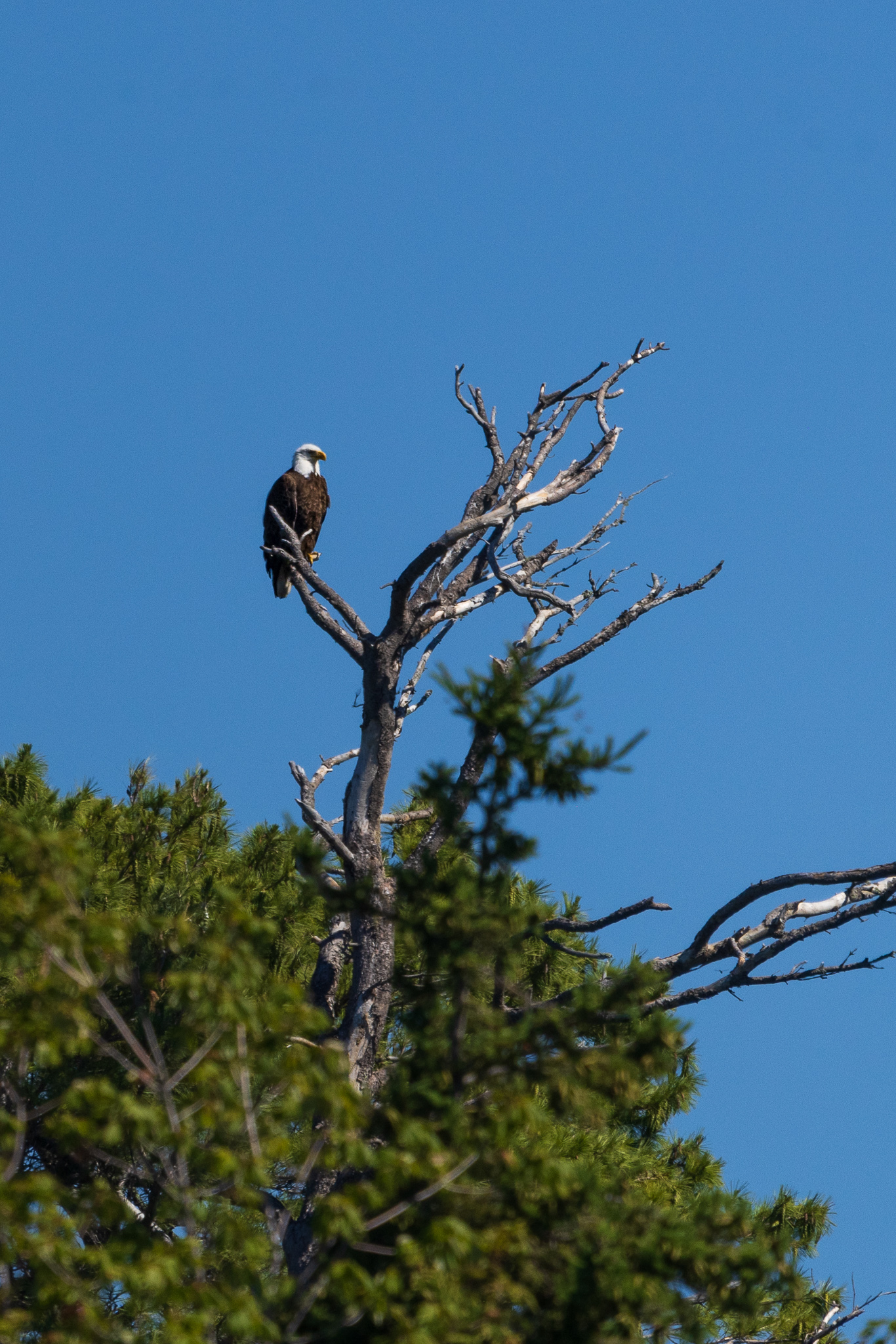
The most common on this tour were families of loons with observant young chicks watching their parents fish.
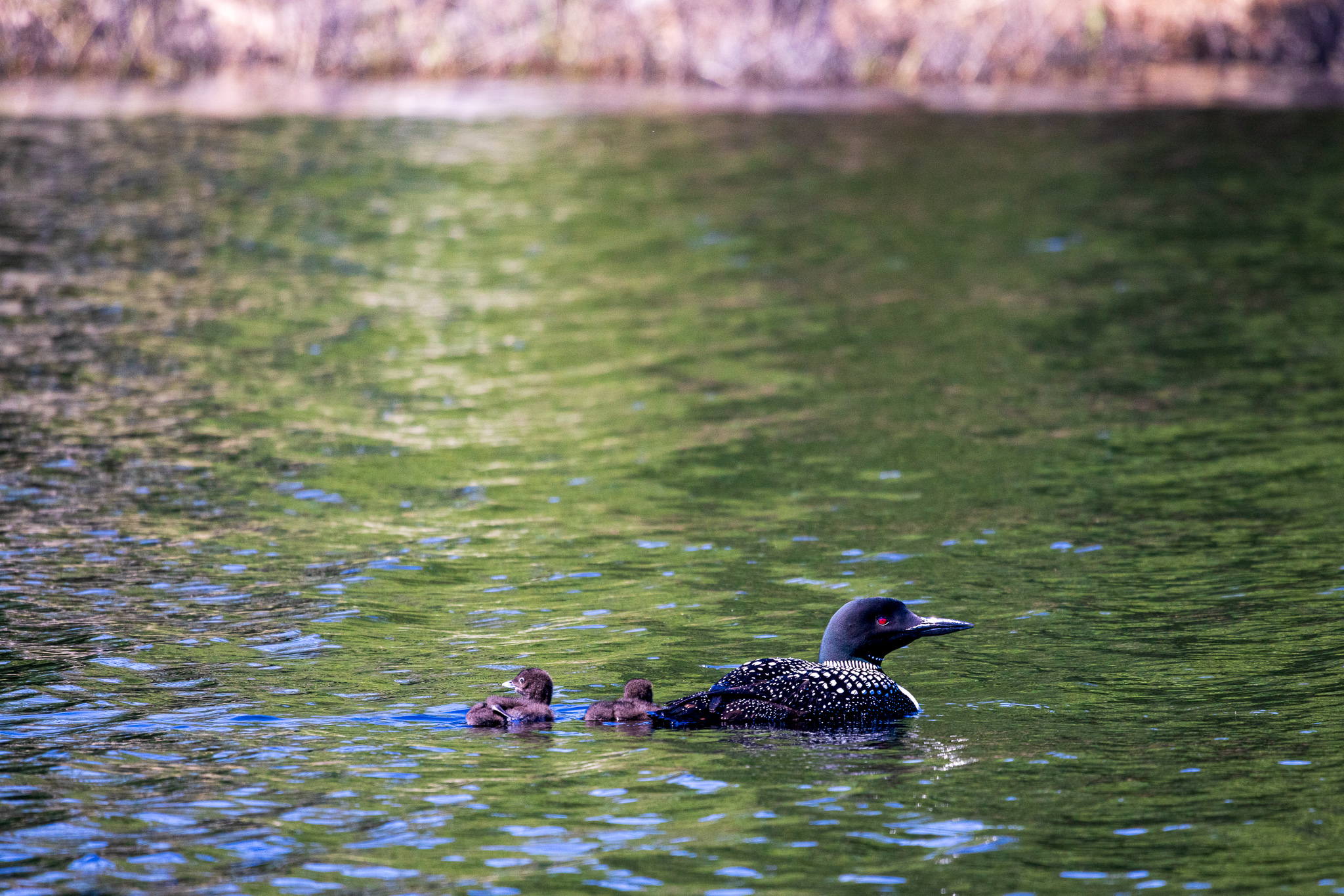
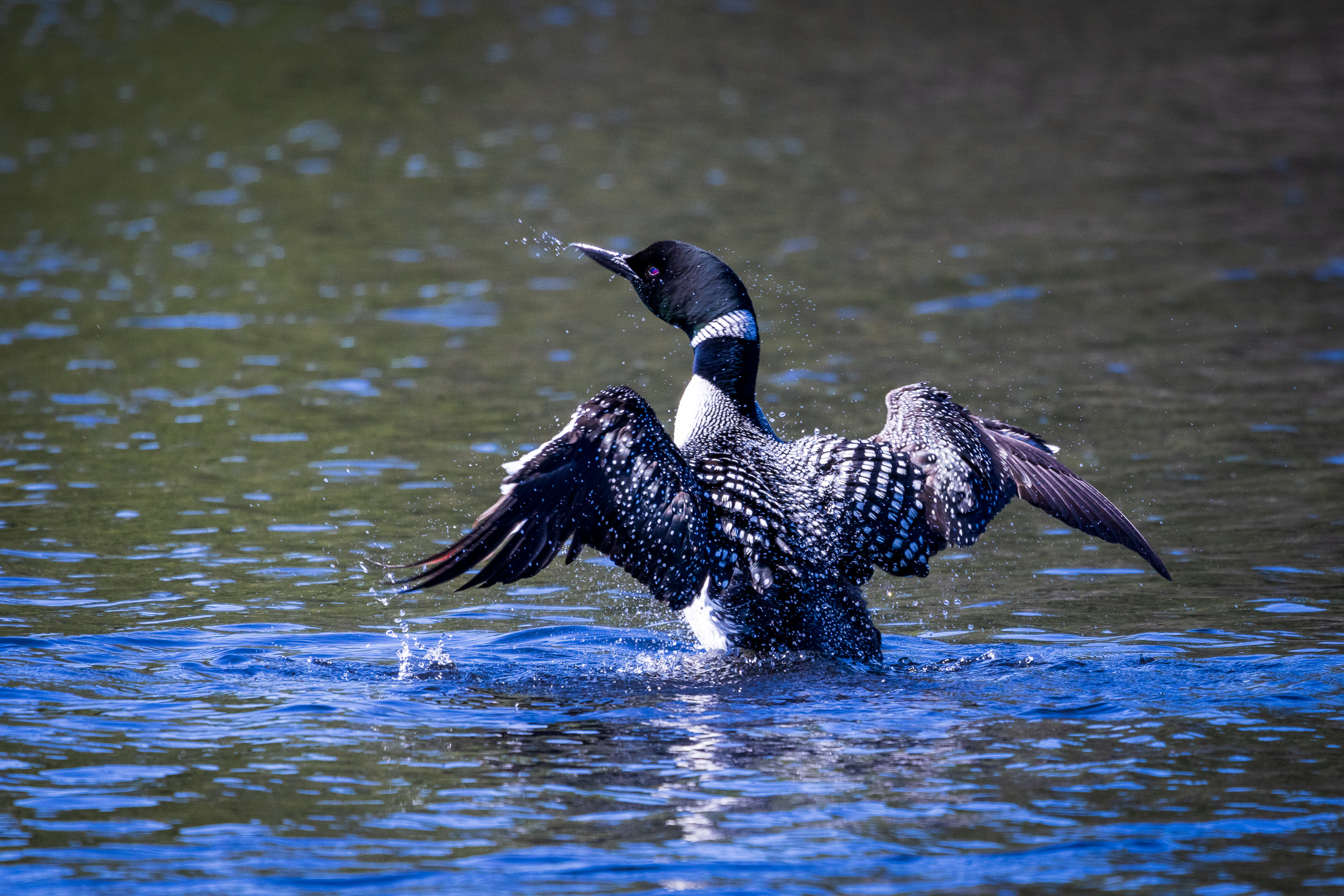
The tour ends at Kettle Falls on the Kabetogama Peninsula. A short hike took us to the hotel through a tree-filled bog where a Western Painted Turtle strategically positioned itself for sunning on a log.
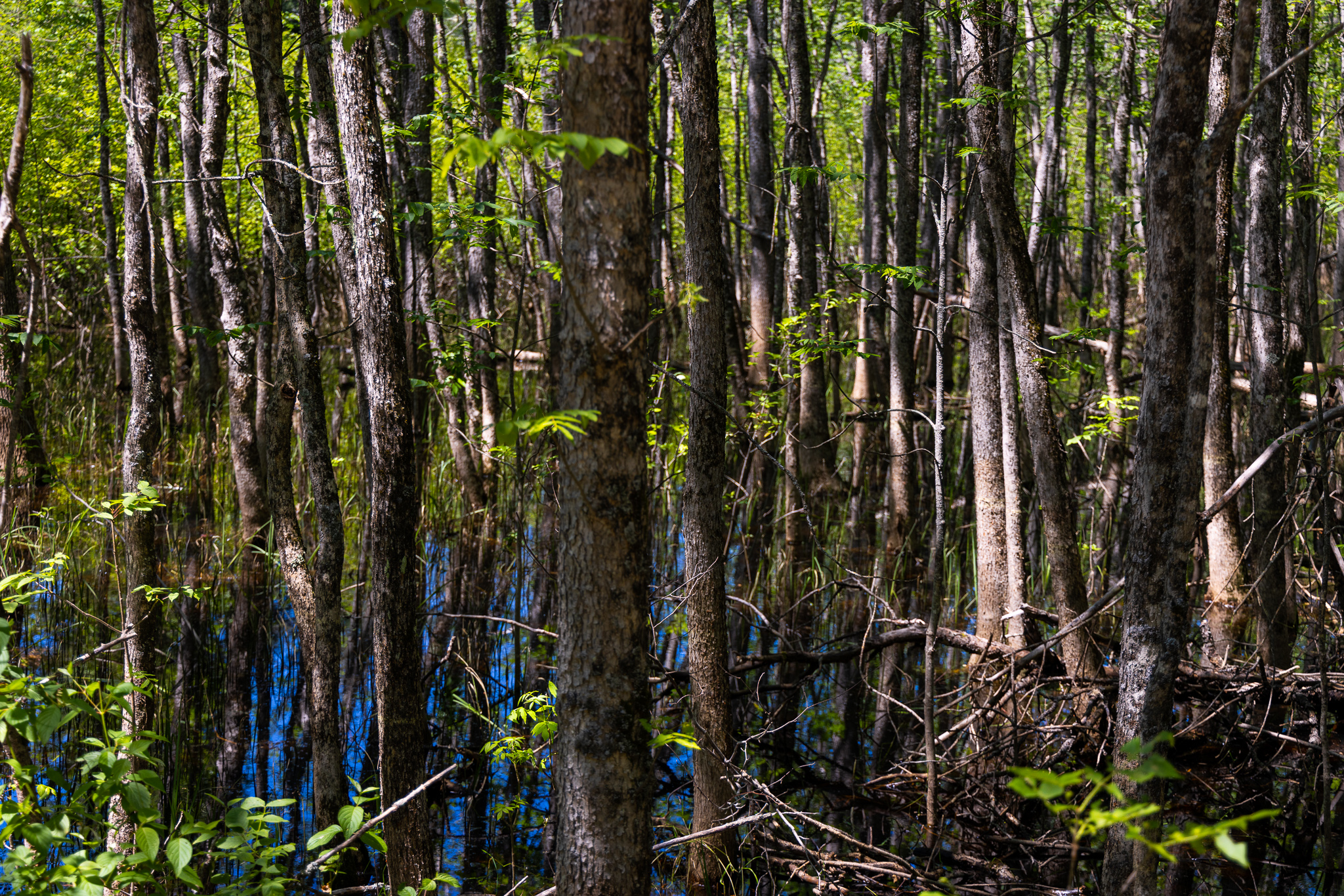
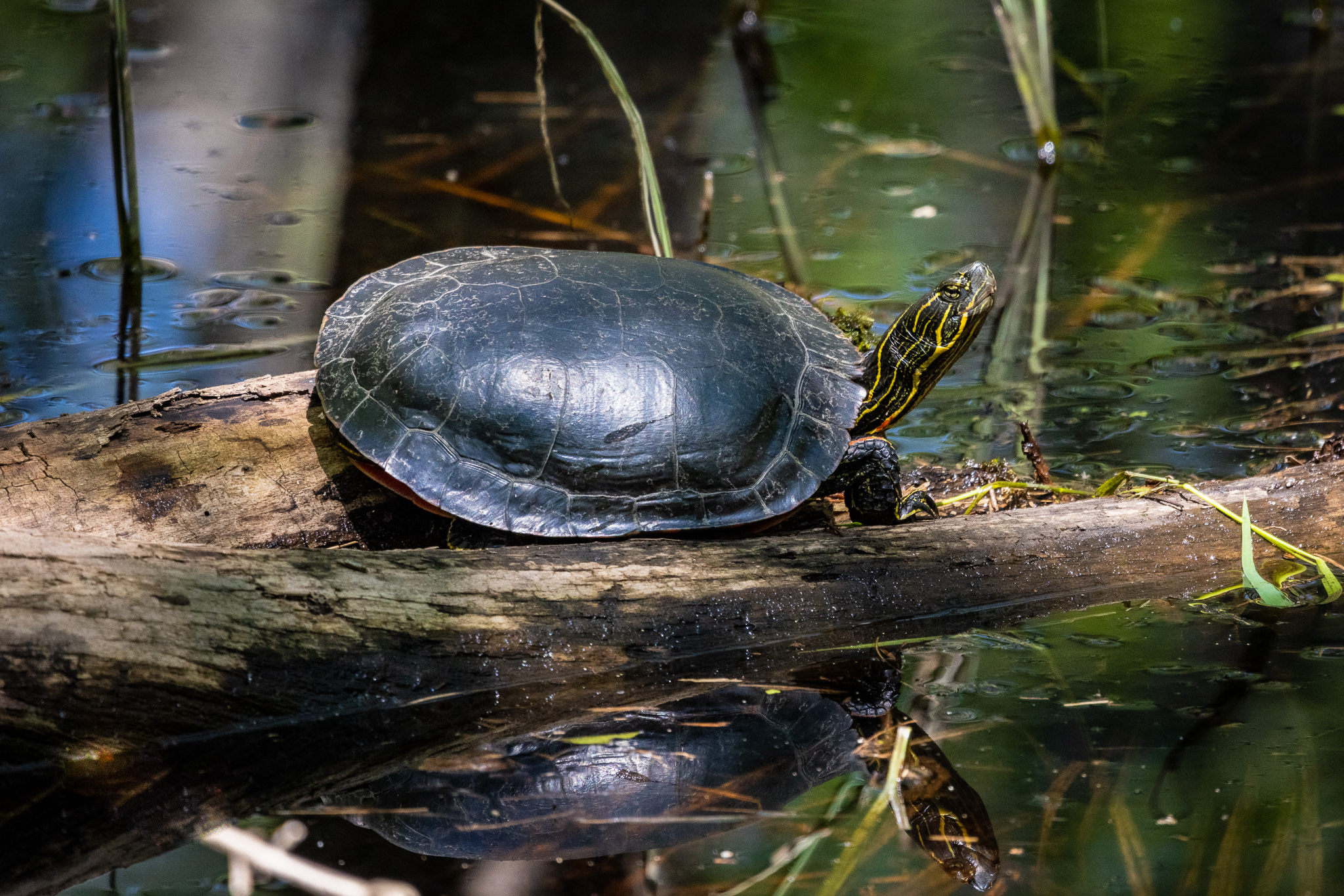
This island is home to the Kettle Falls Hotel. Since 1913, the historic hotel has accommodated guests from stonecutters and masons who built the dams to travelers from the fishing, timber, trapping, trading, and tourism industries. On-site is the “Tiltin’ Hilton” – the hotel bar that preserved the steeply sloping floors, and a restaurant where we had lunch. The hotel is only accessible to guests by water – or air, in the case of fellow lunch guests at the restaurant who arrived by seaplane, who my fellow tour guests and I chatted with over walleye sandwiches and wild rice soup.
Another National Park, Another Troubled Past
As with seemingly all U.S. national parks, Voyageurs is no exception for having a history both exceptional and troubled. The waters are the primary source of the region’s bounty and its exploitation. All of the opportunities and the damage stem from the evolution of industry in the area. Trapping and hunting, timber logging, mining, commercial fishing, and now tourism and recreation are all double-edged swords that sustain people but drain and destroy natural resources.
Voyageurs is named for French Canadian explorers who achieved incredible feats navigating the boundary waters in birchbark canoes during the late 1700s and early 1800s. They paddled back and forth on a 3,000-mile fur trade route between the Canadian Northwest and Montreal to transport beaver pelt hats to satisfy European demand. The Voyageurs were incredible for their feats of navigational prowess, physical strength and endurance and coordinated effort.
However, trappers and traders depended on the indigenous Ojibwe people to meet the colonial demand for furs from the region for nearly everything from guide services to hunting and trapping to food, supplies and medicine. In return, the politics of the trade dragged Indigenous nations into European conflicts, and the realities of the exchanges brought the spread of European diseases that devastated Native populations.
The discovery of gold sparked a brief gold rush in the 1890s, from which many living locals are descendants. At one point, the booming timber industry had stripped the hardwood pine forests to a devastating degree that threatened permanent damage to the region. From mining to commercial fishing to logging, it’s difficult to deny that industry has shifted the balance of species in this delicate ecosystem. Now, the region is under threat from the effects of climate change, invasive species that take hold and force native species out.
But the waterways of Voyageurs National Park and the boundary waters have supported life for hundreds of years. Beginning with Native Americans, through the arrivals of new peoples during transient eras of industry, to modern-day lake life and the hundreds of thousands of people who enjoy visiting and recreating in these waters, they continue to sustain life today. Protecting this life-giving place is of the utmost importance.
Nature writer and founder of the Wilderness Society, Sigurd E. Olson, lived much of his adult life in Minnesota and was an important figure in the passage of the 1964 Wilderness Act and the establishment of Voyageurs National Park in 1975 as the 36th U.S. national park, which helped protect the area from the damaging excess of industry. Improving the balance between humanity and nature helps preserve the space we can all enjoy today.
Next Time at Voyageurs
Staying late in the park to witness the International Dark-Sky Association certified dark skies didn’t work with my travel schedule, so Voyageurs astrophotography and viewing the Northern Lights remain on my bucket list unchecked. I hit the road back to my cabin in Grand Rapids, Minnesota – stopping to photograph trumpeter swans on one of the countless northern Minnesota lakes on the way.
I would have liked to have more time to visit the Ellsworth Rock Garden and follow the ethnobotanical garden self-guided tour curated by the Parks Service. I hope to return to Voyageurs National Park someday soon to rent a kayak or canoe and explore the waters independently, docking on the little islands to explore, view wildlife and picnic.
I have a great streak going of incredible sunsets with perfect light and weather conditions. The final night on the dock of my cabin two hours south of International Falls exceeded all expectations. After a short, gentle rain shower, the rain clouds broke apart and the winds became nearly still. The surface of the lake turned into a pristine mirror reflection for a small rainbow arc that emerged from the puffs of white.
